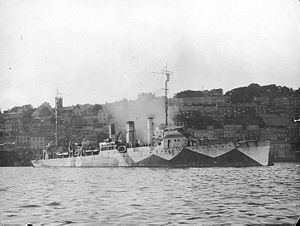Name USS Stockton Commissioned 26 November 1917 Struck 8 January 1941 Length 96 m | Laid down 16 October 1916 Decommissioned 23 October 1940 Launched 21 August 1917 | |
 | ||
Builder William Cramp & Sons Ship and Engine Building Company Philadelphia, Pennsylvania | ||
USS Stockton (DD-73), a Caldwell-class destroyer, served in the United States Navy, and later in the Royal Navy as HMS Ludlow.
Contents
The second US Navy ship named for Commodore Robert F. Stockton (1795–1866), Stockton was laid down on 16 October 1916 by William Cramp & Sons at Philadelphia; launched on 17 July 1917, sponsored by Miss Ellen Emelie De Martelly and commissioned on 26 November 1917, Commander H. A. Baldridge in command.
United States Navy
Stockton spent the last year of World War I assigned to convoy escort and antisubmarine duty, operating out of Queenstown, Ireland. During that time, she engaged an enemy U-boat on at least one occasion. On 30 March 1918, she and Ericsson were escorting the troopship St. Paul on the Queenstown-Liverpool circuit, when Ericsson opened fire on a German submarine. The submerged enemy launched a torpedo at Stockton almost immediately thereafter, and the destroyer narrowly evaded the "fish." The two destroyers dropped patterns of depth charges, but the U-boat managed to evade their attack and escaped. Later that night, Stockton collided with Slieve Bloom near South Stack Light. The destroyer had to put into Liverpool for repairs and the merchantman sank.
Stockton returned to the United States in 1919, and for three years continued to serve with the fleet. On 26 June 1922, she was placed out of commission and laid up at Philadelphia. Stockton was recommissioned on 16 August 1940 and shuttled to Halifax, where she was decommissioned on the 23 August and turned over to the United Kingdom under the provisions of the Destroyers for Bases Agreement.
Stocktonʼs name was struck from the U.S. Naval Vessel Register on 8 January 1941.
Royal Navy
The ship served the Royal Navy as HMS Ludlow (G57) until decommissioning in June 1945.
Following decommissioning, Ludlow was beached in the Firth of Forth off Yellowcraigs beach, Fidra, Dirleton, East Lothian, Scotland, on 15 July 1945 to be used as a rocket target by the Royal Air Force. It is reputed that the first salvo of rockets hit just below the water line and sank her. She now lies off Yellowcraigs beach in 6 metres (20 ft) of water (Ord Survey NT 522 861) and, although well broken up, her remains are still visible just above the surface at low tide.
